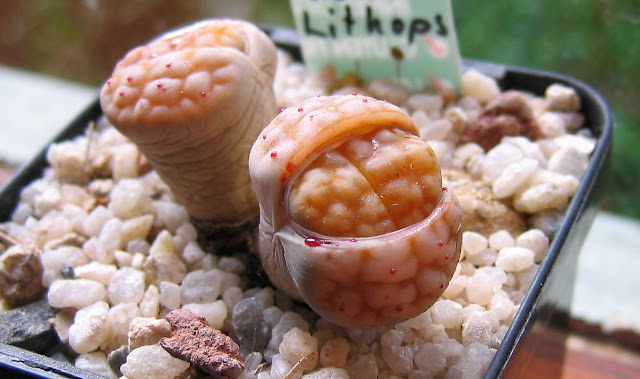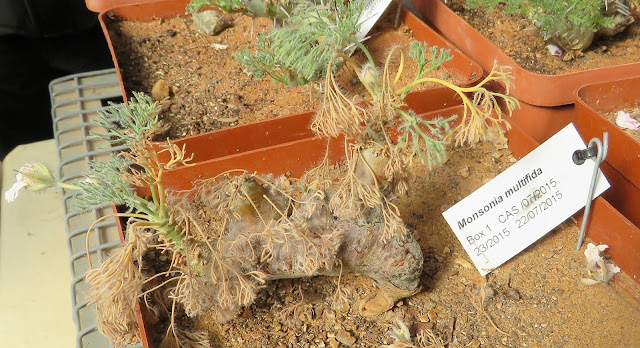Presumed living stones
There are plants that look like rocks. The best known and grown are members of the genus Lithops, meaning stone-face, and sometimes colloquially, Living Stones (not to be confused with the 19th century British missionary and explorer*).
I've used this slightly deceptive image before, of a 'bleeding' plant purchased from the Cactus and Succulent Society of Australia. The red droplets were exuded after being left too long in a hot car, but it does reinforce the creepiness of their form.
There are 108 species of Conophytum, quite of few of them displayed in this botanic garden.
There are many others of this ilk, quite a few of which I saw on display in the glasshouse of the Karoo Desert National Botanical Garden in South Africa. I've posted a few stories from my visit there in August last year, and this is another.
In this case I want to show off a few odd looking succulents, some like rocks, some warty growths and some with just fat stems. Most of them grow local to the botanic garden, many in the harsh desert or near-desert of the Karoo.
In Conophytum, each blob is a pair of leaves, often covered by a velum of some kind, that lives for a single year. Collectively they are called Dumplings or Pebble Plants, because each unit tends to be smaller than those of the Living Stones.
But not always. This front species, Conophytum burgeri, is commonly called the Burger's Onion or Little Light Bulbs. The onions or light bulb photographed here is about 3 cm across. It is only found near mines in the Northern Cape area, originally on the property of the Burger family. When it flowers, a purple bloom bursts from the top of the 'onion'. It's in the family Aizoaceae, with things like Pigface (Carpobrotus), so the flower looks like a daisy but isn't.
There are 108 species of Conophytum, quite of few of them displayed in this botanic garden.
Larryleachia is a different kind of beast all together. It's in the same family as Stapelia, the Apocynaceae, and has similar brown and tan coloured flowers with a scent to attract fly pollinators. I've seen pictures of this species, Larryleachia cactiformis showing a nicely symmetrical conglomerate, so it's not always as disorganised as this one, which looks very like a celeriac root.
Like me, you must be wondering about the origin of this name. In particular, who was Larry Leach? Turns out he was Leslie rather than Larry, an English-born electrical engineer who become interested in the succulents of southern Africa.
Poor old Darrell Plowes, the author of the new genus, first called it Leachia, which turned out to be already used for a daisy, then Leachiella, already used for an obscure epiphytic red alga from the US. Finally Plowes found an available name, Larryleachia - Leslie, it seems, was more commonly known as Larry. (To make things worse, some botanists don't accept the rationale for the genus in the first place and prefer it to be placed back into its original generic home, with another not dissimilar sounding name, Lavrania.)
In fact one of the more symmetrical specimens of Larryleachia I've seen photographed is under the care of Huntington Botanical Gardens, grown with seed harvested from an illegally collected and traded plant. It was confiscated by the US Fish and Wildlife Service and passed on to the botanic garden. Which brings me to one the 'CAS plants' at Karoo, a collection of material intercepted by South African authorities and allocated a confiscation number starting with CAS (Crime Administration System).
In fact one of the more symmetrical specimens of Larryleachia I've seen photographed is under the care of Huntington Botanical Gardens, grown with seed harvested from an illegally collected and traded plant. It was confiscated by the US Fish and Wildlife Service and passed on to the botanic garden. Which brings me to one the 'CAS plants' at Karoo, a collection of material intercepted by South African authorities and allocated a confiscation number starting with CAS (Crime Administration System).
This one is Monsonia multifida. Not a rock, stone or even pebble mimic but one of those plants with a swollen succulent stem, sending out green shoots when the season allows. It's actually in the Geraniaceae family, so a relative of our garden geranium or pelargonium.
This species has a soft pink flower that gives away it's familial relationship but in the glasshouse when I saw it there was only a spent flower and a lot of succulent stem. Although you can see the softly pubescent leaves poking out here and there, some green, some brown.
As you'd expect for a plant being traded illegally, it's rare in nature. In South Africa there are only a few patches of it near the mouth of the Orange River. Each patch is only 20 to 30 metres across, threatened by trampling by stock, diamond mining (including 'dust blowing from exposed mine dumps') and off-road driving. It also occurs in Namibia but again mostly inside a mining area.
The display inside the glasshouse of Karoo Desert National Botanical Garden is therefore both informative, intriguing and important. (Front left here is Christopher Willis, front right is Suzanne Sharrock. Those obscured include Peter Wyse-Jackson, Maïté Delmas and Damian Wrigley.)
*sorry, and not a fresh joke.







Comments